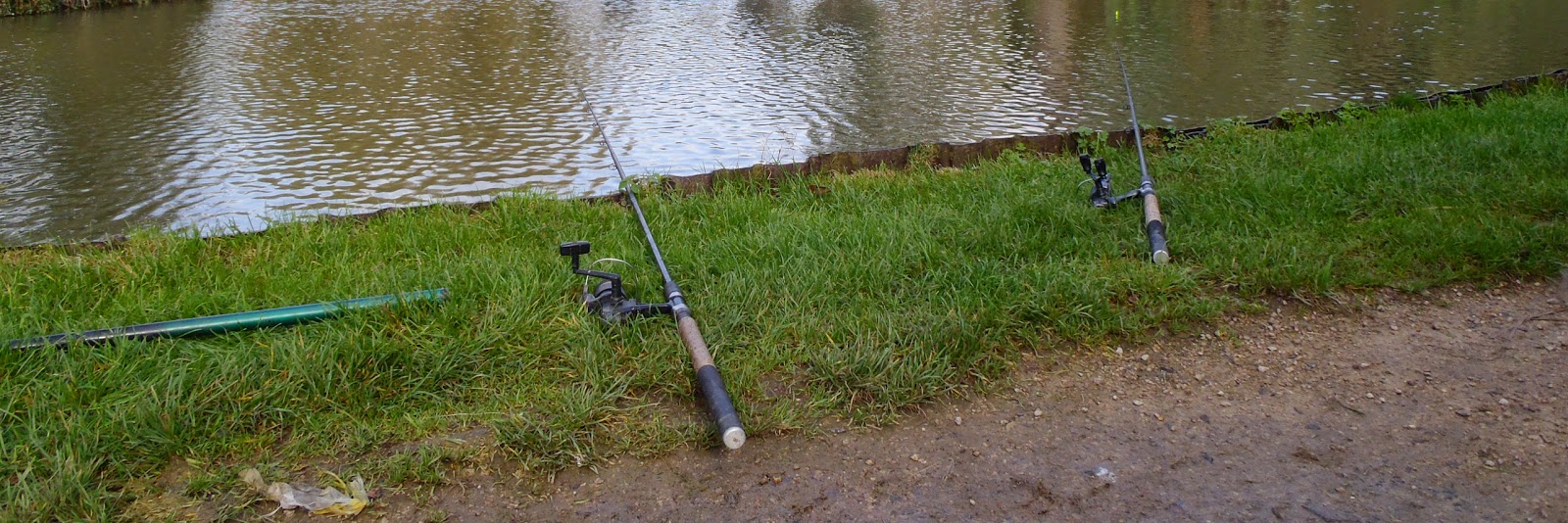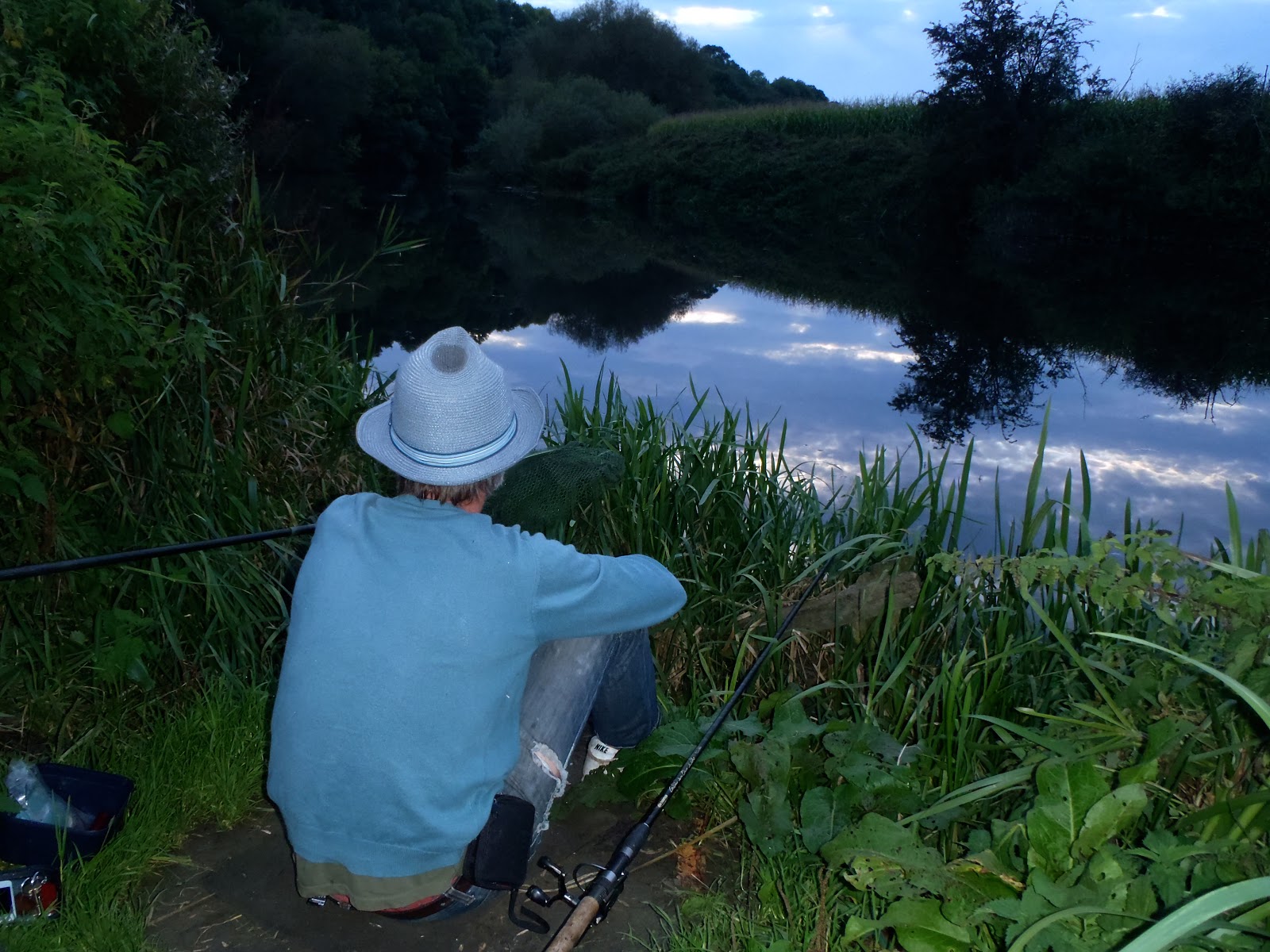I enjoyed a long conversation about zander the other morning with Danny Everitt while we fished the Coventry Canal just round the corner from my home. Now, Danny and myself are pretty experienced at the canal zander fishing malarky and though we have never fished using the same rigs in all the time we've practised the sport, we've somehow converged over time and arrived at the point where what we both have dangling from our rod tops is superficially different but technically speaking pretty much identical in every respect. Small but buoyant cigar shaped floats — because there's no need for big ones when the bait is just yards distant — enough weight to cock them, and a wire trace armed with a large single hook.
The approach we use is similar too. No need for rod rests and all that. We sit out back with our rods lain on the strip of grass between towpath and water, often at a forty-five degree angle in tight swims, with their butts out of the way of Robocyclist, who we see from time to time as a silver/black/spandex/carbon-fibre blur, hurtling through the gap against his handlebar mounted iPhone stopwatch. Each to his own. He has his hobby, we have ours. It's for the best they're kept apart by a few inches. Also, the gear we carry about is pared down to the barest minimum. A seat, a bag, and a net, is all we have besides our rods. Canal zander fishing is not a static pursuit and moving along, and you might five or six times over in the one session, is far easier when you aren't entrenched in a mess of unnecessary tackle.
The only difference between Danny's current practise and my own is in bait choice. I use small slices of dead roach, he uses small live perch. But the emphasis is still on small bait size and for good reason.
| Wrong hook — fifteen runs — two fish banked. No wonder zander are thought a tricky customer... |
Now, we've both experimented with hooks down the years, starting off with tandem trebles, progressing through every conceivable combination of this and that before arriving at the same conclusion — that single hooks in sizes so agricultural they'd make the average coarse angler's eyes water, are the very best tool for the job. You have to understand that using the wrong hook for zander results in head-banging frustration with run after run missed and lightly pricked fish getting off far too easily. When you only net one fish from every three hooked and hook just six from fifteen runs in one hectic hour (as I did one December night back in 2010) then you become acutely aware that something is very wrong at the business end.
| The Gamakatsu 'Finessse Wide Gape' in size 3/0 |
Last time I fished with Danny after zeds he was using O'Shaughnessy hooks size 1/0 and I was using the Mustad 'Ultimate Bass' in size 2/0. Today he was using a carp hook, and it was the biggest one he could find on the shelves, while I was using a hook under trial as an alternative to the Mustad — the Gamakatsu 'Finesse Wide Gap'. This is a hook only available in America and was kindly thrown across the pond by Steve Dedrick (Steve in Colorado) on recommendation as a great hook for walleye and therefore the closely related zander.
Apart from the straight point of mine and the in-curved point of Danny's, they were, to all intents and purposes, identical. And just as large as each other even though his was a size 1 and mine a 3/0 according to the packets!
 |
| General hook size chart. Perhaps my 3/0 is not nearly big enough for double figure fish? |
We agreed. They weren't that large at all. Not in the jaw of a decent zander, but certainly not in the gob of any size of pike. What was 'large' about them was only that they were in use for coarse fish. We then agreed on a second point — that many coarse anglers lack sea fishing experience and have therefore developed something of a fetish for small hooks and are always looking at ways to reduce size. Which, as we also agreed, is a nonsense. Hooks should be the right size for the job, big or small, and these huge hooks of ours were spot on.
 |
| For bass in this size range sea anglers routinely choose hook sizes in the order of 4/0 - 6/0 That's a great deal larger than a size 6! About ten times the size... |
Use such a hook at Bury Hill, though, and you'd be frogmarched out the gates by the owner. Trebles are banned outright there and single hooks a must. But he enforces tench hooks on his predator hunters. Size 6 is the maximum allowed. Because Bury Hill is the country's zander Mecca, this ruling has forced intelligent anglers who fish the place to refine small hook/small bait rigs to get the best from it. However, using such small hooks results in false data. You are going to get very many 'dropped' runs and many lost fish before you bank one. The upshot of this is the reinforcement of an old myth originally perpetuated by pike anglers fishing for zander with pike gear. And that is...
That they are 'finicky'.
 |
| A size 6 circle and a strip of trout. Looks all wrong but what is the essential difference between this and a single maggot on a size 18? |
We don't think so!
Danny doesn't have dropped runs and neither do I. They just don't let go of a bait once they pick it up, in my experience. When I caught a one at Bury Hill, it messed with the bait for a full minute before deciding to move off with it. The float dithered on the spot, but it didn't run. I knew it must be zander picking it up because the bite was typical of many I get down the cut and such bites must be struck when the float moves away in one direction (no matter how slowly) because the fish is solo, not in a competitive pack, and is mouthing the bait, not eating it beforehand. Sure enough, when it did move off, I struck against the direction of the run and hooked it. It was a near twelve-pounder, but I would have never had hooked it at all if I'd struck early.
I was very lucky to bank it though. Very lucky not to be thrown off too, because I used a size 6 circle hook that day. At least that's what it said on the packet...
The reason such large hooks as we both currently employ work so very well mechanically is because the gape is very wide. The reason the bait is hooked so that it dangles off the bend rather than being impaled upon on it, is that the gape must not be clogged with flesh otherwise it is rendered ineffectual because it is the bend of the hook that banks zander, not the point. That wide unimpeded gape is critical because there's the bony plate of the upper jaw to contend with and it must wrap around it. Use anything smaller and you are merely hoping to hook up by finding some little bit of flesh inside the mouth and there's precious little of that, hence the reputation zander have for falling off.
 |
| The Gamakatsu and its typical hook hold. Zander should always be hooked like this so far as I'm concerned because if not it's the wrong hook for the job in a very bony gob. |
The Gamakatsu is almost as wide as it is long — nearly a circle hook but for the lack of a sharply inturned point. Fish are almost always hooked cleanly in the scissors through the thin membrane between the bony plate of the upper jaw and the skull but for some reason are never hooked down the throat and that's a blessing because unhooking the fish is a formality, not a surgical operation. Big wide gape hooks avoid all that, in fact I'm so outrageously confident in them that I don't even check my bag for forceps before I go. Can't remember when I last had to use them, actually.
 |
| The Mustad 'Ultimate Bass' cleanly hooked through the scissors of a small zander. |
But even with the long-shanked Mustad, it is the large gape that makes it work so well. I refer you to Mick Newey, who was having a horrible time of it when he began trying for the zander in his local canal. He was experiencing exactly what Danny and I had encountered years ago. Lots of runs, few fish. I recommended the Mustad bass hook and what happened then was he hooked and banked almost every single one thereafter. He didn't catch any large ones though, so the hook looks enormous in their mouths, but hook a five-pounder or better and that size discrepancy vanishes, and five-pounds plus is what we fish for, after all, is it not?
The only downside we agreed upon was that such large hooks might once in a while impale small zander through the orbit of the eye.
Well, little zander make for a very tasty fillet, don't they?












